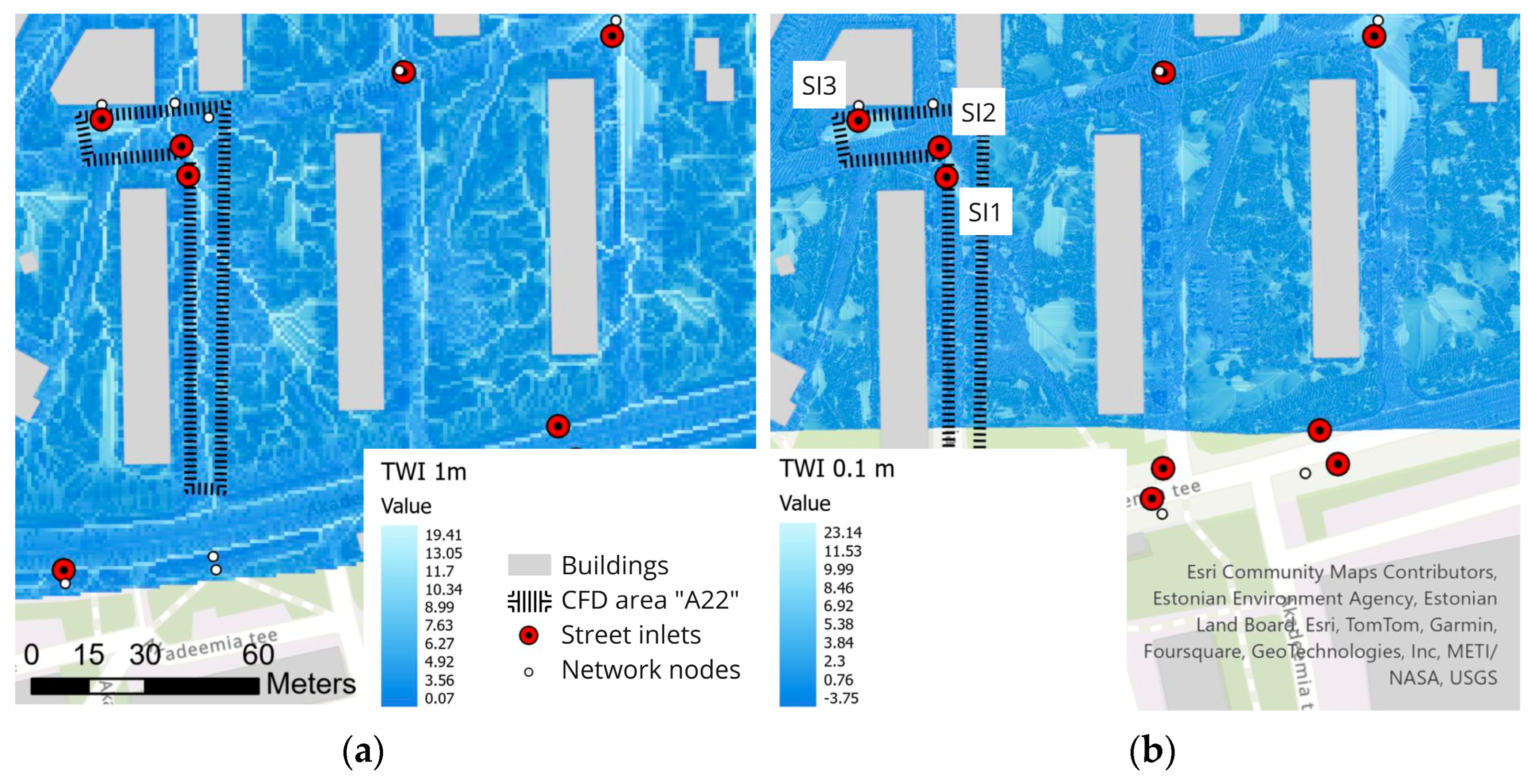Integrating Drone-Captured Sub-Catchment Topography with Multiphase CFD Modelling to Enhance Urban Stormwater Management †
Abstract
1. Introduction
2. Materials and Methods
3. Results
4. Discussion
Author Contributions
Funding
Institutional Review Board Statement
Informed Consent Statement
Data Availability Statement
Acknowledgments
Conflicts of Interest
References
- Truu, M.; Annus, I.; Roosimägi, J.; Kändler, N.; Vassiljev, A.; Kaur, K. Integrated Decision Support System for Pluvial Flood-Resilient Spatial Planning in Urban Areas. Water 2021, 13, 3340. [Google Scholar] [CrossRef]
- Abily, M.; Duluc, C.M.; Faes, J.B.; Gourbesville, P. Performance Assessment of Modelling Tools for High Resolution Runoff Simulation over an Industrial Site. J. Hydroinform. 2013, 15, 1296–1311. [Google Scholar] [CrossRef]
- Stein, U.; Bueb, B.; Englund, A.; Elelman, R.; Amorsi, N.; Lombardo, F.; Corchero, A.; Brékine, A.; Lopez Aquillar, F.; Ferri, M. Digitalisation in the Water Sector. Recommendations for Policy Developments at EU Level; Publications Office of the European Union: Luxembourg, 2022; ISBN 978-92-95080-52-2. [Google Scholar] [CrossRef]
- Gilmour, L.; Stroulia, E. Ortho-Photogrammetry for Prefabricated Energy-Efficiency Retrofits. Automat. Constr. 2022, 134, 104082. [Google Scholar] [CrossRef]
- Whitman, J.B.; Perez, M.A.; Sturgill, R.E. NCHRP Synthesis 609: Use of Unmanned Aerial Systems for Inspection of Stormwater Best Management Practices; Transportation Research Board: Washington, DC, USA, 2023; ISBN 978-0-309-69874-0. [Google Scholar]
- Hirt, C.W.; Nichols, B.D. Volume of Fluid (VOF) Method for the Dynamics of Free Boundaries. J. Comput. Phys. 1981, 39, 201–225. [Google Scholar] [CrossRef]
- Deshpande, S.S.; Anumolu, L.; Trujillo, M.F. Evaluating the Performance of the Two-Phase Flow Solver interFoam. Comput. Sci. Discov. 2012, 5, 014016. [Google Scholar] [CrossRef]
- Courant, R.; Friedrichs, K.; Lewy, H. Über Die Partiellen Differenzengleichungen Der Mathematischen Physik. Math. Ann. 1928, 100, 32–74. [Google Scholar] [CrossRef]
- Altunel, A.O. The Effect of DEM Resolution on Topographic Wetness Index Calculation and Visualization: An Insight to the Hidden Danger Unraveled in Bozkurt in August, 2021. Int. J. Eng. Geosci. 2023, 8, 165–172. [Google Scholar] [CrossRef]
- Winkler, D.; Zischg, J.; Rauch, W. Virtual Reality in Urban Water Management: Communicating Urban Flooding with Particle-Based CFD Simulations. Water Sci. Technol. 2018, 77, 518–524. [Google Scholar] [CrossRef] [PubMed]


Disclaimer/Publisher’s Note: The statements, opinions and data contained in all publications are solely those of the individual author(s) and contributor(s) and not of MDPI and/or the editor(s). MDPI and/or the editor(s) disclaim responsibility for any injury to people or property resulting from any ideas, methods, instructions or products referred to in the content. |
© 2024 by the authors. Licensee MDPI, Basel, Switzerland. This article is an open access article distributed under the terms and conditions of the Creative Commons Attribution (CC BY) license (https://creativecommons.org/licenses/by/4.0/).
Share and Cite
Kaur, K.; Annus, I.; Truu, M.; Kändler, N.; Paalmäe, I. Integrating Drone-Captured Sub-Catchment Topography with Multiphase CFD Modelling to Enhance Urban Stormwater Management. Eng. Proc. 2024, 69, 31. https://doi.org/10.3390/engproc2024069031
Kaur K, Annus I, Truu M, Kändler N, Paalmäe I. Integrating Drone-Captured Sub-Catchment Topography with Multiphase CFD Modelling to Enhance Urban Stormwater Management. Engineering Proceedings. 2024; 69(1):31. https://doi.org/10.3390/engproc2024069031
Chicago/Turabian StyleKaur, Katrin, Ivar Annus, Murel Truu, Nils Kändler, and Iris Paalmäe. 2024. "Integrating Drone-Captured Sub-Catchment Topography with Multiphase CFD Modelling to Enhance Urban Stormwater Management" Engineering Proceedings 69, no. 1: 31. https://doi.org/10.3390/engproc2024069031
APA StyleKaur, K., Annus, I., Truu, M., Kändler, N., & Paalmäe, I. (2024). Integrating Drone-Captured Sub-Catchment Topography with Multiphase CFD Modelling to Enhance Urban Stormwater Management. Engineering Proceedings, 69(1), 31. https://doi.org/10.3390/engproc2024069031




